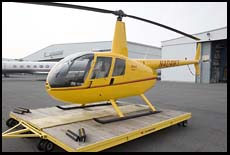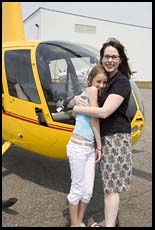

|
Preparing for helicopter ground schoolat East Coast Aero Club; updated March 2010 |
 This document is to help prepare customers who are registered for our
two-hour helicopter introductory ground school. This document includes
the following sections:
This document is to help prepare customers who are registered for our
two-hour helicopter introductory ground school. This document includes
the following sections:
Learning to fly will exercise all the corners of your brain that don't get used in a typical desk job. You'll learn a little bit of science and engineering, practice hand-eye coordination, learn to think while speeding through the air, and manage your emotions (only the young, foolish, or both, are unafraid at first; it isn't natural for a human to be up in the air; the trick is not becoming fearless, but behaving rationally even when afraid). [See this article on why aviation is a great hobby for more.]
Your independent reading plus our ground school will answer a lot of questions you might have had about helicopters. What's common among airplanes and helicopters? What's the tail rotor for? How are the pilot's control inputs transmitted to the spinning wings? Can a helicopter really glide and land without damage after running out of gas or suffering a mechanical failure? How does Air Traffic Control work at a towered airport like Hanscom Field? Do you need to make a reservation in advance? What can you do with a personal helicopter?
We'll usually have at least four or five FAA-certified flight instructors around to answer any other questions that you might haveabout either airplanes or helicopters.
Short answer: It is required by Federal law.
Long answer: You can call 781-274-6322 to book an intro airplane lesson at East Coast Aero Club, show up at Hanscom without having done any reading, have a short conversation on the ground about the flight and positive exchange of flight controls, jump in an airplane with an instructor, and do a significant amount of flying with a bit of real-time coaching by the instructor. It is both legal and safe, partly because the typical trainer airplane flies itself for a minute or two without any control inputs. Airplanes are stable.
Helicopters, on the other hand, are inherently unstable. A pilot must be constantly applying correct control inputs to keep the helicopter reasonably level. Just a few seconds of the wrong control inputs and the helicopter could be crashed into the ground. The modern helicopter was developed during World War II (history) Until the 1980s, nearly all helicopter students were military. They studied for months in a classroom before getting anywhere near a machine. By the time they sat down in the helicopter, they knew exactly how each part worked. Training accidents were rare. In the late 1970s, Frank Robinson revolutionized the industry by developing first the R22 and the R44. Suddenly helicopters were affordable for civilians and civilian flight schools. Flight schools offered introductory lessons with very little preparation and accidents became common (example: a July 2005 accident in Nashua, New Hampshire; the student told NTSB investigators that he had received minimal preflight ground instruction).
The FAA, alarmed at the high accident rate, modified Part 61 of Title 14 of the Code of Federal Regulations with SFAR 73. As a matter of Federal law, successful ground school training, certified with a logbook endorsement by an FAA-certified flight instructor, is required before anyone may "manipulate the controls of a Robinson model R-22 or R-44 helicopter".
Helicopter training, if done carefully, can be safe. One of our instructors has flown more than 4000 accident-free hours spanning three decades, most of which was teaching people to fly Robinson helicopters. No East Coast Aero Club graduate has ever crashed a helicopter and we work hard to preserve this record by giving customers the best training that we can. We want you to be completely comfortable when you get in front of the Robinson controls and consequently we are happy to invite you to repeat ground school at no additional charge or talk to our instructors one-on-one.
Please be on time as only those who were present for the core of the training may legally be signed off by the instructor. Typically the course will be held in a conference room on the third floor of the Civil Air Terminal at Hanscom (Google Map). If you're not feeling well or did not have time to do all of the reading, please stay at home and schedule yourself into another class. Your Groupon will not expire until March 2011. We want you to be at your best for all of your training, both ground and flight.
The outline:
If everyone arrives prepared with the reading, the preceding topics can be covered in two hours. There is a coffee/question break in the middle and the final exam is given after the lesson, so the whole process takes closer to three hours.
By FAA regulation, flight training operates differently. Forty hours are the minimum required experience to get a pilot's license, for example, but a person can only get the license if both an instructor and an FAA examiner fly with that person and agree that he or she meets the proficiency standards. Similarly for ground school, there cannot be any C students promoted to the next grade. Everyone must develop an adequate understanding of the material before progressing. After your flight, we keep a copy of your final exam in our files to prove that we trained you to a sufficiently high standard.
Anyone who has done the recommended reading and taken notes during the class should be able to pass the test. Exams will be graded right after the class and instructors will sign off an FAA SFAR 73 endorsement in your temporary logbook (we provide this to you).
What if you don't pass? You're welcome to go home, hit the books, come back and repeat ground school.
Send an email to helicopters@eastcoastaeroclub.com.